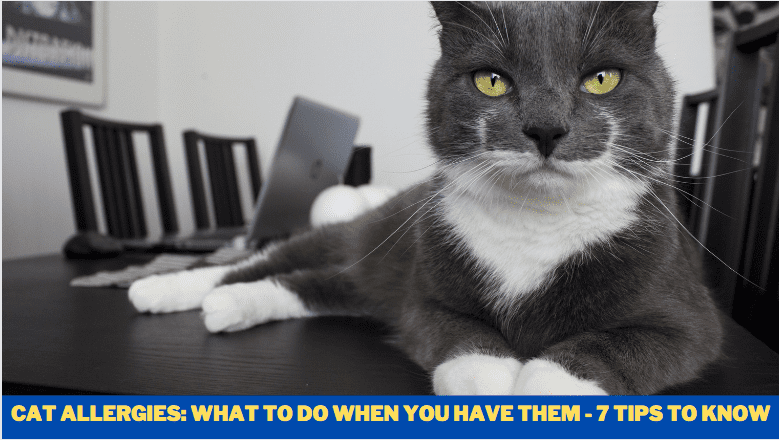Cat Allergies: What to Do When You Have Them
Living with cats can result in frequent sneezing, watery eyes, runny noses, and wheezing for some poor humans. According to the journal Environmental Health Perspectives, severe cat allergies can worsen asthma symptoms.
Even while dealing with cat allergies might be a pain, trying to live without that little bundle of purring love is even worse. That, of course, is not an option either. So, how can people who suffer from cat allergies maintain some level of comfort while sharing their home with a feline companion?
If you have cat allergies and live with a cat, having a cat allergy remedy or two on hand will make your life a lot simpler.
Continue reading to find out how to choose the best kitty partner, how to keep your home as free of dander as possible, and how to provide routine care for your pet.
What Causes Cat Allergies and How Do They Develop?
If you have cat allergies, you’re not alone; in fact, you’re in the minority.
According to the Asthma and Allergy Foundation of America, humans are twice as likely as they are to be allergic to cats as they are to dogs. But what causes humans to develop cat allergies in the first place is unclear.
Every day, your immune system is hard at work searching for and eliminating foreign chemicals (or eject them through a sneeze).
There are differences in the sensitivity of immune systems amongst people.
Cat allergy sufferers’ immune systems respond to minute proteins that are released by your cat in her dander (dead skin cells), saliva, and urine, which are generally harmless to them.
Many people feel that pet hair is the source of the problem, yet pet hair is not an allergen in and of itself. When your cat sheds, though, the hair can absorb pet dander, allowing it to be dispersed around your home at random intervals.
Furniture, mattresses, and carpets can all become encrusted with it, and it can even survive for an extended period of time merely hung in the air.
Some people are fortunate enough to build a long-term immunity to cat allergies as they grow older. While it is possible that allergic reactions can develop as a result of more exposure, this is not always the case.
It’s also possible that someone who has never had a cat allergy before will develop one in the future.
If you suddenly find yourself sneezing, wheezing, or sniffling while you are in the presence of your cat, you should consult your doctor about whether you may have an allergy to cats.
Choosing a Cat That Doesn’t Sneeze
You can’t help but sneeze when you see your furry friend for the first time, can you? Starting with the cat you choose to bring home, you may, however, minimize the likelihood of you or a family member developing allergic responses to it.
A shorthaired cat is preferable to a longhaired cat for allergy-prone pet parents, yet there is no such thing as a hypoallergenic cat.
Shorthaired cats shed less than longhaired cats, which means there is less cat hair in your environment for dander to attach itself to.
Hairless cats shed even less than their shorthaired counterparts, which is understandable given the circumstances.
The sphynx is a little cat with no hair and a very loving personality. Despite being a rarer breed, sphynx cats are often fairly expensive, and they will not completely eliminate allergies because hairless cats still produce saliva and dander.
Other breeds that are suitable for those who are allergic to cats are the Balinese, Cornish rex, Devon Rex, and Siberian husky.
Cleaning Your Home When You Have Cat Allergies
Once you have a cat, one of the most important things you can do to keep allergies at bay is to be diligent around the house.
- Cleaning smooth surfaces in the home (including walls and floors) on a regular basis is a good idea. Microscopically little dander can adhere to any surface and is there even if you are not aware of its presence.
- Make frequent use of a vacuum with a filter, and steam clean your carpets. It will also be beneficial to restrict the cat’s access to carpeted areas.
- Any bedding or blankets that your cat uses should be washed on a regular basis.
- Cat-free zones should be established in specific places, such as the allergic person’s bedroom.
- Replace your upholstered furniture with something more durable. Furniture with a cloth covering, such as chairs and couches, can trap a lot of allergens and be difficult to clean. You can either try to keep your cat away from your upholstery (good luck with that!) or consider buying in wood, plastic, or leather furniture that is easy to wipe down.
- Remove the drapes from your windows. Curtains, like upholstered furniture, can act as a magnet for cat hair and dander. Take into consideration replacing them with shades or other window treatments that are simple to clean. If you decide to maintain your curtains, make sure to wash them on a regular basis.
- Invest in a HEPA (high-efficiency particulate air) filter to keep your indoor air clean. These can be added to your furnace or air conditioner, or they can be used as a freestanding unit to cleanse the air. Regardless of which model you choose, their primary function is to minimize microscopic particles in the air.
Taking Good Care of Your Cat
Other ways to decrease the impact of cat allergies include things you should already be doing to care for your pet, such as brushing and cleaning his teeth.
By reducing shedding, regular brushing can aid in the decrease of allergic reactions – and your cat will thank you for the reduction in hairballs! When she’s shedding her winter coat in the spring, you can brush her more frequently than in the winter.
It is preferable to have someone who is not allergic to cats take on the job of brushing the cat and to do so near a window or outside on a leash if at all possible.
Keeping the litter box clean on a regular basis will also aid in the reduction of allergies, as the same proteins that are present in cat saliva, hair, and dander are also found in the urine of the cat.
Once again, it is preferable if this responsibility is taken on by someone who is not allergic to cats. (What a fantastic strategy to avoid cleaning the litter box!) –
Finally, you can give your cat a bath with warm water and pet-safe soap to see if it helps. Some cats may find this practically impossible, whereas others aren’t bothered by it at all.
It is more effective to brush your cat’s fur than to give her regular baths because it will help minimize her dander.
You’ve done all of these precautions, but you’re still sneezing all the time. Consult with your doctor to determine whether antihistamines or allergy injections are appropriate for you.
For many people, living with cat allergies is a possibility as long as they take the necessary precautions to avoid exposure.
When picking a cat, keep allergies in mind, eliminate allergens in your home, properly groom and clean up after your pet, and you and your cat will be set up for many years of sneeze-free companionship!
Fact-Finding:
Thanks for reading and have a great day! Cat Allergies: What to Do When You Have Them – 7 Tips to know?
Please post your thoughts in the comments section if you have any. Please feel free to share!

